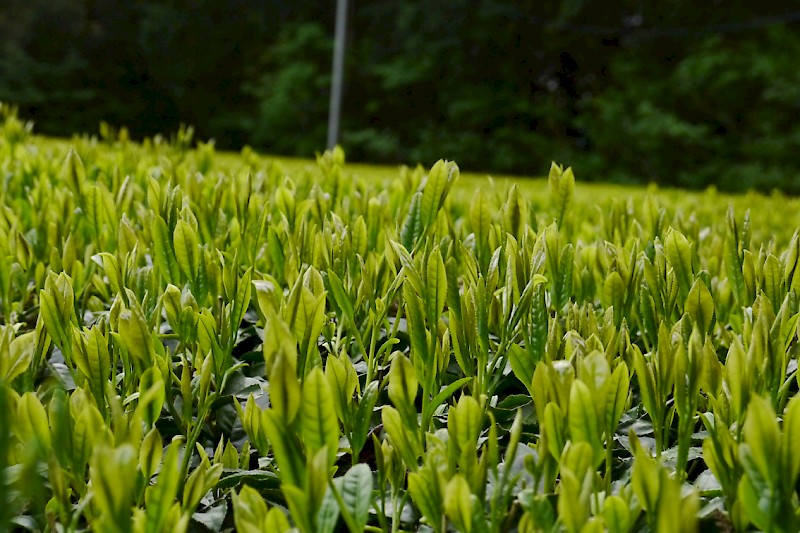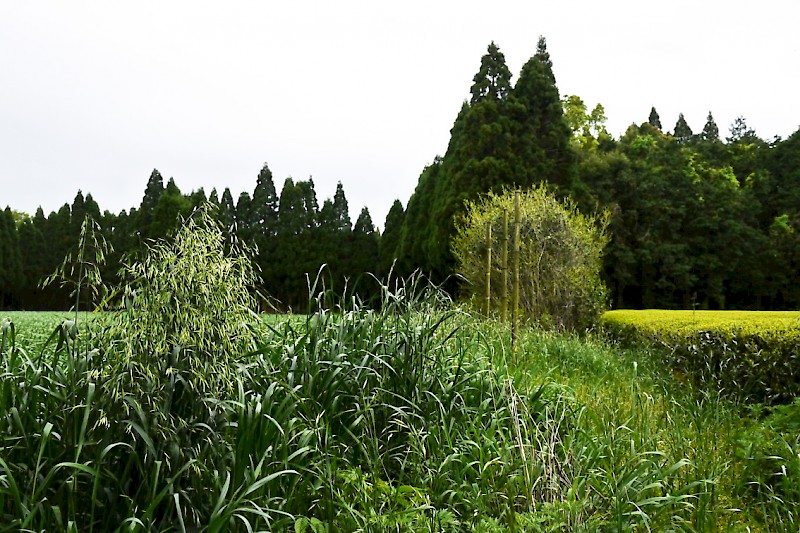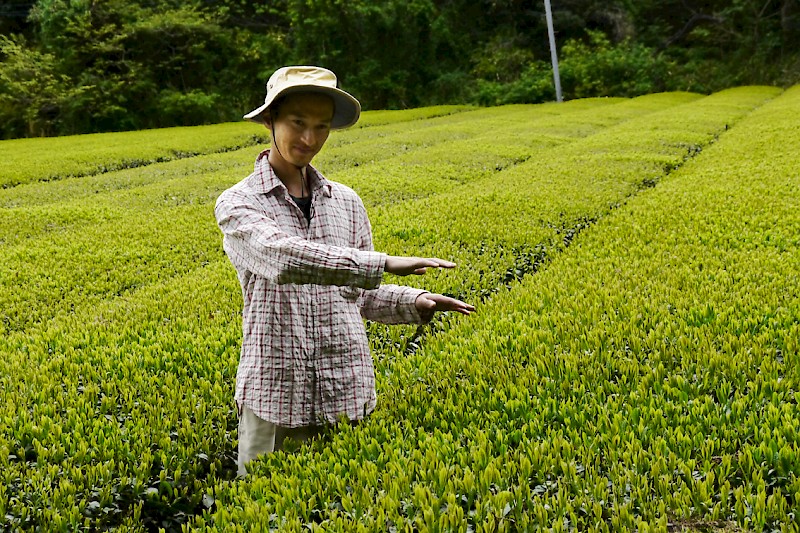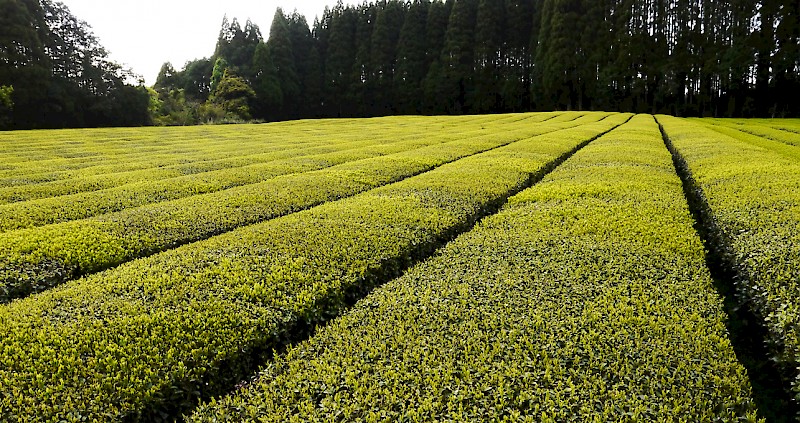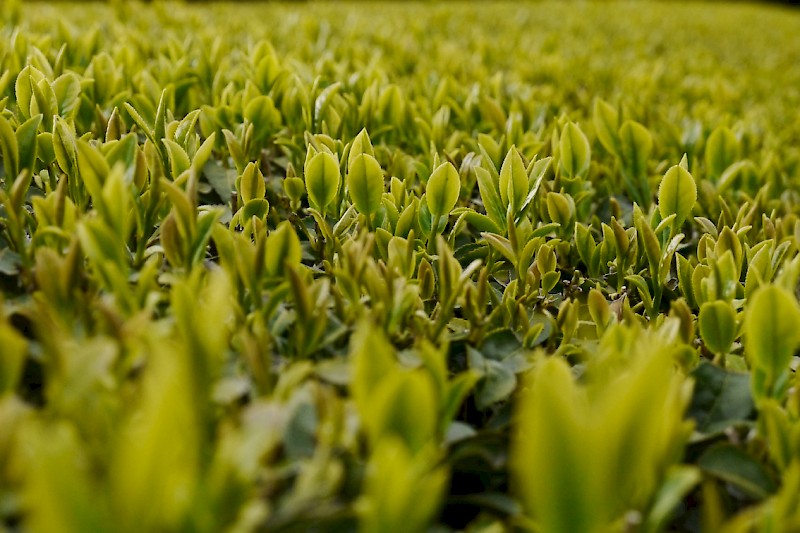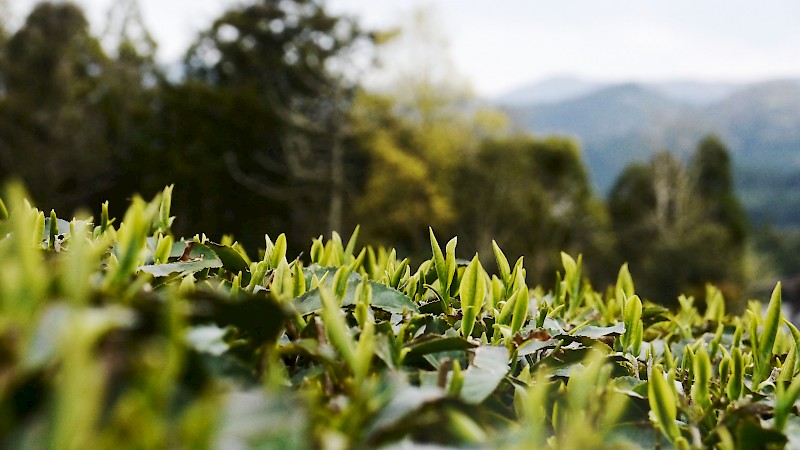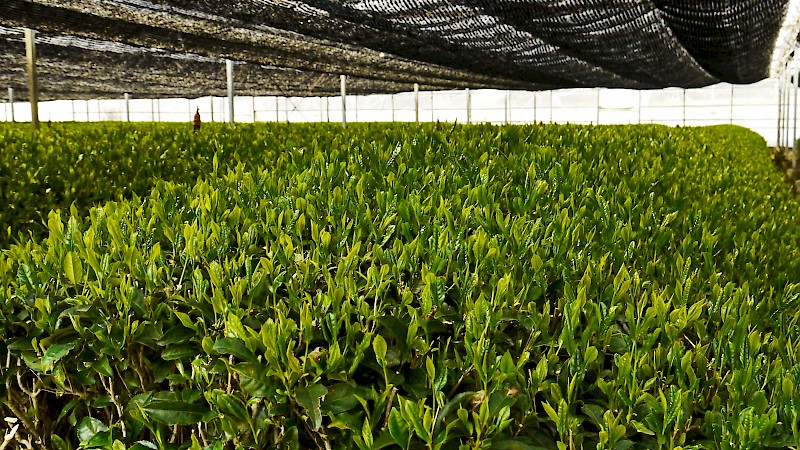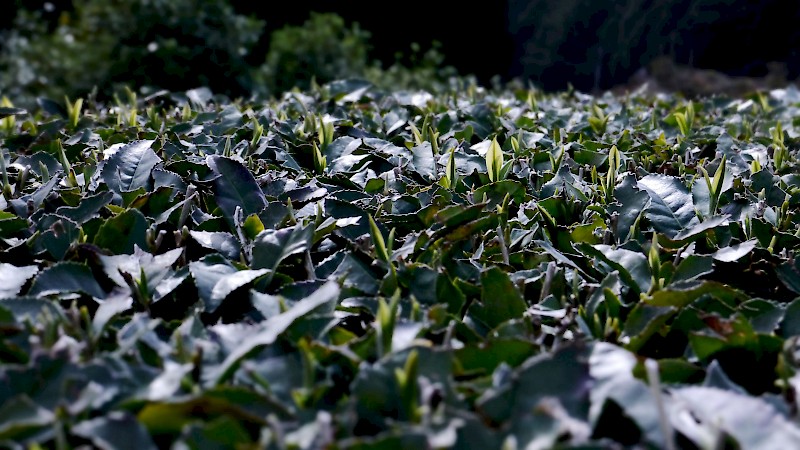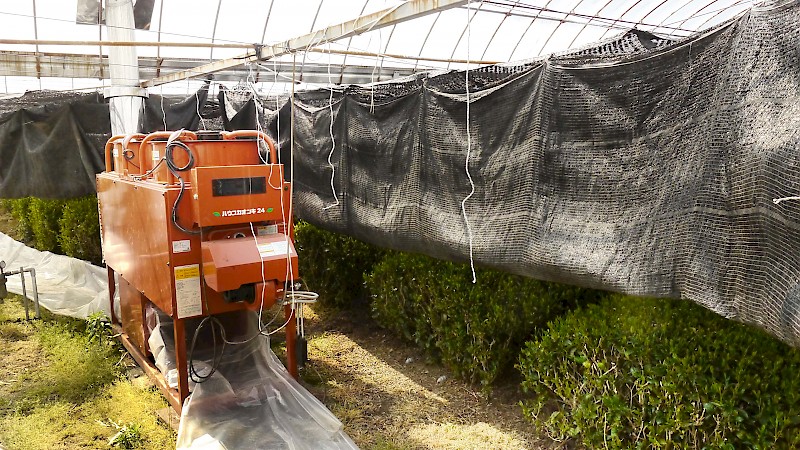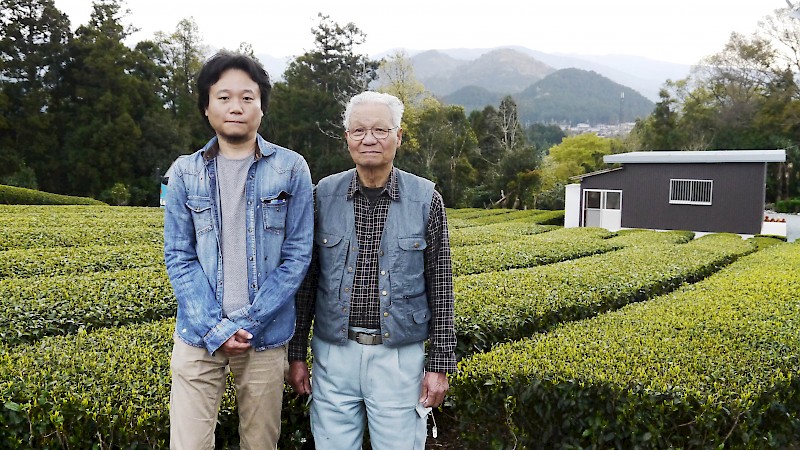MARIMO tea - Manufacture, Import & Wholesale
BLOG - April / May 2017 - Japan Tea Travel Blog
26th April 2017 - KIRISHIMA – Tea, art & breath-taking volcano landscapes
This year, 2017, it is exactly 10 years since we first came to Kirishima. How this happened is probably an interesting story in itself. It was the time shortly before we started our own tea import and wholesale of Japanese green tea: In some tea shops where we bought Japanese green tea for ourselves, there were some elegant green teas from Kirishima. Moreover they were organically grown teas, which was rather an excemption for Japanese tea at that time. As students we had almost no money, so we only treated ourselves to one of these teas a single time for a special occasion. However, the atmosphere of the tea, and everything we associated with „tea from Kirishima“ stayed in our memory. And it shaped our image of Kirishima before we even had a chance to travel to Kirishima for the first time by ourselves.
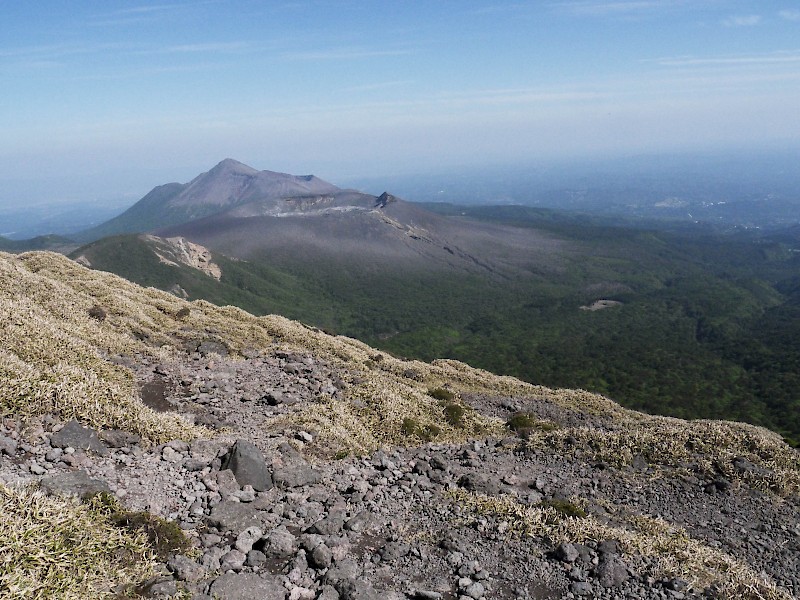
KIRISHIMA – View from the Karakuni volcano crater to Takachihonomine
In 2007 finally we had the chance to stay in Japan for a longer time, thanks to our work for a market research about organic shops in Tokyo. We used our only three free days to take a Shinkansen express train to Kyushu, where we travelled as fast as possible into the direction of Kirishima. We looked for a suitable train station to discover one of the organic Kirishima tea gardens, by foot if possible. However, we had no idea where exactly the organic tea gardens in Kirishima were located. So we got off the train in the middle of the mountains, because we had heard that the garden was in the middle of the Kirishima mountains. Just as we started to get some orientation about the area, it started to rain very heavily. We quickly understood that we would not have the luck to find a tea garden in Kirishima that day. But we did not want to give up, and at least we wanted to discover the Kirishima mountains a little bit. So we simply walked up-hill, hoping to further enter the volcano landscape of the Kirishima mountains. Yet, it was raining more and more, and we had no other option but to look for a shelter.
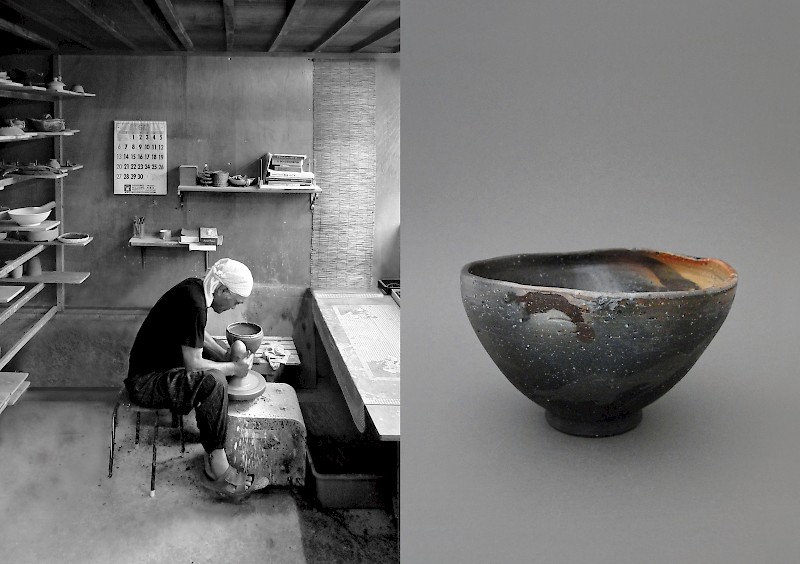
Narieda Shinichiro and his matcha bowl KARAKUNI
This shelter, as fortune would have it, was the pottery atelier of NARIEDA Shinichiro, which thus we had the honour to discover in 2007. So, visiting Narieda Shinichiro today, we celebrated the 10-years-anniversary of our first meeting in 2007, and of our cooperation with his wonderful ceramics, which we since then received from him and could make available to many art and tea enthusiasts in Europe. During today’s visit at the place of the 67-years-old artist NARIEDA, besides celebrating the 10th anniversary of our first meeting, we also had the opportunity to look at some of his special works. From those, besides three matcha bowls, he also entrusted one of his larger Kabin (vase) to us, for which the ceramist is famous in his home country.
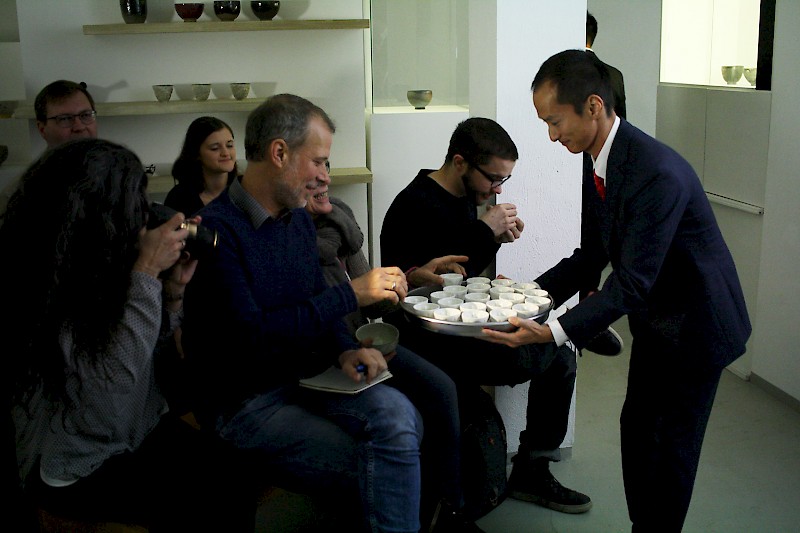
Shutaro gives out Kirishima tea to our guests
There is so much to write about Kirishima, art from Kirishima, and tea from Kirishima, that the time for today’s blog entry is really to short. Yet two points just have to be mentioned. In 2007 we were incredibly lucky to meet ceramist NARIEDA Shinichiro, but our search for the aforementioned „Kirishima organic tea gardens“ was not so succesful. So we kept our eyes open in the following years, and in 2014 finally meet Osamu Hayashi, father of Shutaro Hayashi, who then ran the family’s tea garden in the 4th generation. Good timing, because in the meantime the management of the family garden passed to son Shutaro Hayashi, who is in the same age as us. This is a very exciting and enriching experience for us, because usually tea producers in Japan are rather in the age of our parents.
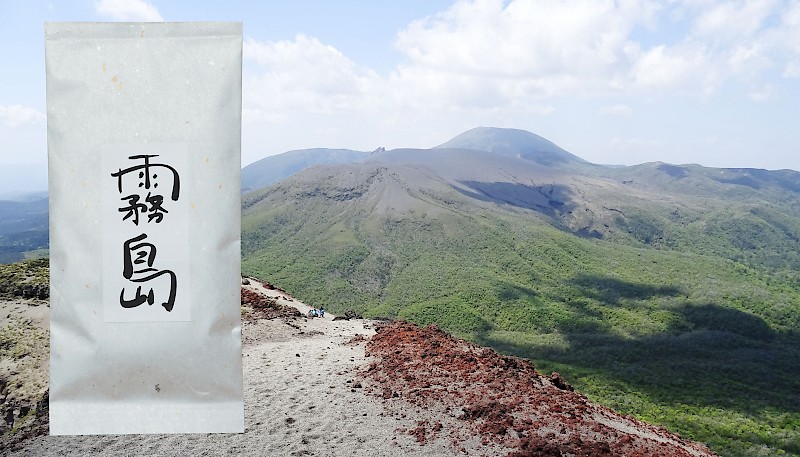
Kirishima Aracha Shincha by Shutaro Hayashi from Kirishima
Now, in the year 2017, on the occasion of our now 3-years-long cooperation, there is something special: The “KIRISHIMA ARACHA SHINCHA – Kabuse Asatsuyu cultivar”. As the “Asatsuyu” in the name says, it is a Shincha from the tea bush varietal Asatsuyu, which moreover has three other special features: The Asatsuyu bushes are shaded [Kabuse], and they will come to us in Europe in the condition of Aracha [non-finalised green tea], to have a 100 percent Shincha taste in the sense of a very young tea. Moreover it is the “children” of Asatsuyu bushes, which are genetically not absolutely identical with their “parents” [this is called Mishou in Japanese]. Thus they can only be found in the tea garden of Shutaro Hayashi. So, it is a Kirishima Aracha Shincha from Kabuse Mishou Asatsuyu bushes, and there can be no other comparable Shincha like it. Well, and there is only 10kg – let’s see if there is anything left for us to try it ourselves. If not, we are looking forward to hearing the feedback of those who will have had the chance to try the KIRISHIMA ARACHA SHINCHA – Kabuse Asatsuyu cultivar 2017.
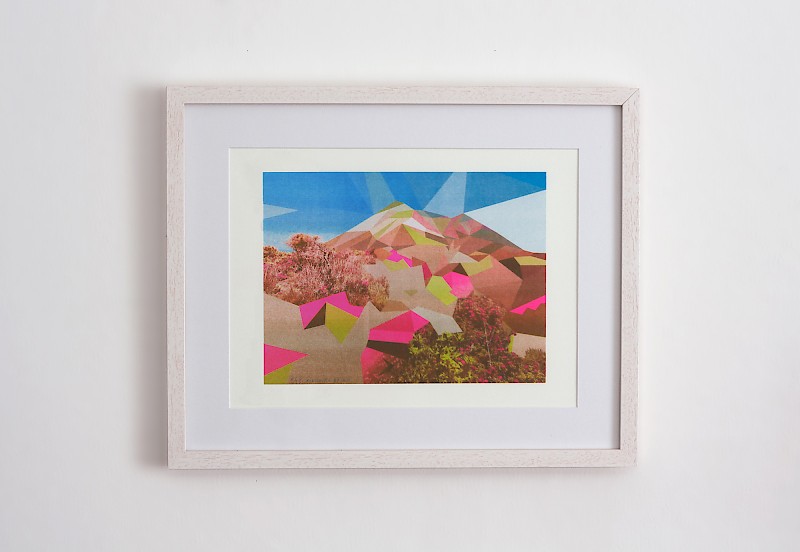
Kirishima Risography Print 2 of 25
Certainly our tea travels in Japan are often so hectic, that there is hardly any time to really peacefully enjoy all the exciting and joyful moments that happen here every day. Yet, we try to at least keep one day free every year, to go for a mountain hike, which is really dedicated to enjoying the landscape and the atmosphere of this enchanted surrounding. A wonderful choice for this is a climb on one of the volcanoes or volcano craters of the chain of Kirishima volcanoes. While a “mountain climb” even in our ears sounds like “hiking”, and maybe sounds like a nice leisure activity, but not so much like a special inspiration, each time we had the chance to, we understand that a volcanoe hike on the chain of Kirishima volcanoes is one of the most inspiring moments ever. This is also how the Kirishima print above was born (a risography print with 25 pieces). If you are interested in where it is available please contact office@marimo.eu.
25th April 2017 - Kirishima tea garden of Shutaro Hayashi – Harvest preparations
In the very beginning of the new week, our journey leads us to Kirishima, where we meet Shutaro, Kenji and their father Osamu Hayashi treffen. Shutaro Hayashi welcomes us at the train station. He has come directly from the tea garden, fully prepared: farmer‘s shoes, garden trousers, hat, and a shirt for working in the tea garden. So, in the first moments of our reunion we already know that he is thinking about the harvest time, which will start soon. We also that he is completely in his element. He also tells us that this year’s harvest will probably be very stressful, with very long work days. The early varieties are getting closer to the late varieties. So some varieties might be ready for harvest at the same time. However, harvest has not begun yet. Only in the last days it has been getting warmer, and the young sprouts are still very small.
Kirishima Asatsuyu Mishou bushes
First, we drive to the smaller one of the two tea gardens of the Hayashi family. It has been more than 10 years ago, that the family took over this piece of land of around one hectare. Before it was also used for ecological tea, but at some point the owner was to old to continue with the garden. Moreover he had no successors who wanted to continue the garden. We noticed this phenomenon in many parts of Japan. Less and less young people want to do the hard work in the tea garden, and prefer to move to the large cities, in the hope of finding an office job. Fortunately, there is also young people like Shutaro and Kenji Hayashi, who really enjoy the work in the tea field and tea production, even have plans for expanding their garden and production step by step, and are full of energy to create new and special tea qualities.
Kirishima tea garden – new tea garden parcel
Next to the tea garden with about one hectare, there is a small pasture, about 0,4 hectare. It is now used for organic pasture grass. But within the next year, a new organic tea garden will be planted here. The Hayashis will exchange fields with the farmer who owns this parcel. They will get this piece of land next to their tea garden, and in exchange the farmer gets a piece of land from the Hayashis, which is not in use at the moment but even closer to the barn. Shutaro is thinking about growing Tsuyu Hikari here, if he can get cuttings from this variety. Directly next to it, he shows us a field, which seems to have greenish patches at the moment. All bushes started sprouting at around the same time, but the leaf color is not completely homogeneous. We guess right away what it is: Mishou, plants grown from the seeds of a mother variety, and not Zairai bushes because they would be much more different from each other. In this case, it is the Mishou descendants of Asatsuyu cultivar. Therefore the bushes are very similar to Asatsuyu bushes, but not 100% the same. Some leaves are still a bit reddish, which is typical for Asatsuyu cultivar when it is not shaded. As soon as it is shaded, which Shutaro Hayashi is planning for the next days, the plant develops an intense, almost neon-like bright green leaf colour. On the next day, Tuesday, indeed the shading of this parcel starts, so that in the beginning of May it will be possible to harvest a wonderful Shincha.
Shutaro Hayashi tells us about the shading of the Kirishima Asatsuyu Mishou bushes
By the way, the Kirishima Tennen Gyokuro is not from this field, it is produced from a completely single varietal Asatsuyu. At the other location, Shutaro planted Asatsuyu bushes grown from cuttings. This is where the Tennen Gyokuro comes from. It is a few minutes journey to the other tea garden. Here we meet Shutaro’s brother Kenji and their father Osamu. We continue the topic of bush varieties. Shutaro’s father Osamu Hayashi shows us a parcel where they want keep Zairaishu also in the future. Shutaro‘s and his father’s preferences are quite different. Osamu rather likes the flowery-scented Kanaya Midori and the rounded Zairaishu. In contrast, Shutaro is enthusiastic about the fine-elegant and extravagant varietals as Asatsuyu, Oku Yutaka and Asanoka. In some parts of the tea garden the old Zairai bushes will be taken out, so that other, rare varieties can grow there in, each in small parcels. But this one parcel should stay a Zairai parcel. We are very happy about this: we personally appreciate the Zairai of Shutaro Hayashi’s tea garden very much. Also because it reaches an excellent quality in the second harvest, while the other varieties rather have their best time in the first harvest.
Zairaishu tea field from Shutaro Hayashi in Kirishima
Close-up Zairaishu tea field from Shutaro Hayashi in Kirishima
15th April 2017 - News from Mie: Iwao and Kimihiko Hayashi
Today’s appointment takes us to the prefecture Mie, about 100km east of Kyoto. Mie has a tea cultivation tradition of more than 800 years. The first tea seeds that were put into the soil here came from Kyoto, after arriving to Japan from China.
Today we meet Iwao Hayashi and his son Kimihiko. This year, Kimihiko picks us up from the train station with the car. On the way, we already ask him how far his tea bushes have progressed, and tell him about other tea gardens where the tea bushes have started to sprout rather late or not at all yet, even in warmer regions further south. Kimihiko Hayashi tells us that his tea bushes are sprouting around seven to ten days later than in recent years‘ average too. So, it is also a late year for Mie. About the time of harvest in Mie, 2016 was an average year, with harvest beginning on 5th May.
Young shoots in Iwao Hayashi’s organic tea garden
For 2017, the harvest date cannot be foreseen yet. However, Kimihiko expects a date around 10th May, and his father Iwao an even later first harvest day, depending on how the weather develops in the next weeks.
More about Shincha in our Shincha Blog 2017.
After we asked for the young sprouts, Kimihiko offers us to visit an experimental tea garden, surrounded by a greenhouse, which is located in the neighbourhood. In this cultivation project, tea is cultivated under mostly controlled conditions. By controlling several cultivation factors, the effectiveness of various fertilisers can be compared directly, without side effects of different locations, soil conditions or rainfall. This reminds Tobias a lot of his times as a student at the Department of Plant Breeding. Nevertheless, this cultivation project here is, of course, not an organic tea garden, as the operation of a greenhouse and its high energy use are not compatible with the idea of an organic way of cultivating tea. Here we can see sprouts that are clearly larger – ready for harvest next week.
Young sprouts in the tea greenhouse (Kabuse Yabukita) of an experimental tea cultivation project
Young sprouts in the same cultivation project outdoors (Yabukita) for comparison
However, in the region Mie, this early and fast growth is only possible with greenhouse cultivation. Inside, temperatures are around 28°C to 30°C. And at night, sometimes the greenhouse is heated, so that the young sprouts are not destroyed by night frost.
Heater inside the greenhouse
To controll for the factor water availability, artificial watering is necessary. For this field of about a quarter hectare size, 3000 litres of water are needed per day. This amount seems quite a lot, but compared to natural rainfall it is not much. Therefore the tea from this greenhouse tastes less intense. To gain a beautiful colour, here the bushes are shaded for about one week. However, it seems to be not so bad that the tea is not extraordinarily intense in taste: in the end, it is not for drinking, but will be offered to the gods in Ise Shrine, one of the most important Japanese national shrines. Being the very first Shincha from this region makes it special, and thereby worthy to be offered. Unfortunately it is no organic tea, but then again the Japanese gods are not going to drink it.
Arriving at the house of the Hayashi family, we now also meet Iwao Hayashi and his wife. 80-year-old Iwao’s health condition is not perfect at the moment, but he is still joking a lot. At the moment he has difficulties walking, every step feels uncomfortable. But recently it is getting better again, so he expects to be in good shape again for harvest time. He also says that he is already 80 years old and, indeed, quite energetic for his age. Asking about his wife’s condition, he answers jokingly: very good, but then she is still young – six years younger than him. To us, both of them appear very lively and cheerful.
Kimihiko and Iwao Hayashi in their organic tea garden in the prefecture Mie
Last year we met Iwaos grandson Shuhei, who works in the family garden for two years now. During our last visit, he was busy with the tea harvest. His proud grandfather tells us that his grandson is doing a very good job. We also hear that 23-years-old Shuhei married last year and has a daughter now. Of course, great-grandfather Iwao Hayashi is very proud of this too.
Iwao tells us that it has been raining a lot since February. He adds that lot of rainfall in February and March is very good for the tea of the first harvest. During this time, the plants are gathering energy for the new sprouts – the Shincha LINK and Tokujou Sencha. Therefore he expects a good tea year 2017. It is still going to take a while before the new teas can be harvested, and until we can taste the first samples, but we are already looking forward a lot.

